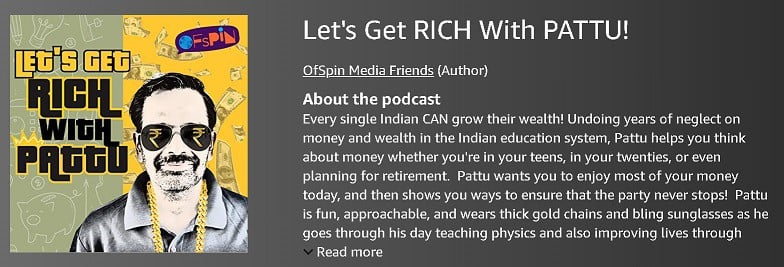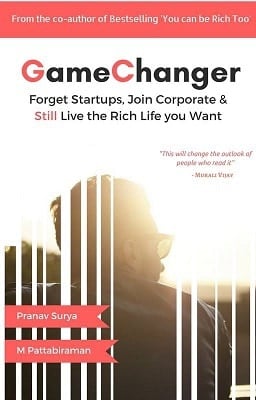Last Updated on October 8, 2023 at 1:36 pm
Have you ever wondered why a corporate fixed deposit offers a higher rate of return than a bank deposit? Have you ever considered investing in corporate FDs, but worried about the “risks”? In this post, I simple ways to invest in corporate fixed deposits.
Before we begin, allow me to point out that You Can Be Rich Too With Goal Based Investing is now available at Rs. 307 – a 23% discount at Amazon.in or at Infibeam for at the same price plus an additional 10% discount with coupon code REPUBLIC10
The reason why corporate FDs offer higher return is because their reputation is not as good as a bank FD. So if we look at only the return, we ignore the risk. If we look at only the return, then we have to settle for less. There is a middle path via debt mutual funds.
Before we consider the types of debt mutual funds to invest in, let us ask another question: What is the difference between Equity Mutual Fund Investing vs Stock Investing? This is key to understanding the difference between a debt mutual fund and corporate FD.
Join 32,000+ readers and get free money management solutions delivered to your inbox! Subscribe to get posts via email! (Link takes you to our email sign-up form)
🔥Want to create a complete financial plan? Learn goal-based investing? Exclusive access to our DIY tools? Increase your income with your skills? Enjoy massive discounts on our robo-advisory tool & courses! 🔥
A stock investor typically has anywhere between 5-15 stocks (above that it is a mutual fund folio!). The risk is concentrated in these stocks and so is the reward. A fund manager cannot by design afford to take such concentrated bets. A fund cannot hold more than 10% of a stock. This dilutes both the risk and (potential) reward.
So a person who can afford to take such a concentrated risk can choose direct equity over mutual funds. The reward may or may not be higher. It is stupid to assume any old joe can be a fund manager.
The analogy with corporate FDs should be clear. Buying a corporate FD is taking a highly concentrated risk, even if the issuer is AAA rated. If the rating drops, interest payments will get delayed and there could also be a default.
A debt mutual fund spread this risk across a basket of corporate FDs (and other types of bonds) – the same 10% limit now applies to debt funds also after the JP Morgan Debacle.
There are three choices here, each with its own pros and cons.
Open-ended income funds
Open-ended income or corporate bonds funds is probably the most straight forward choice. A fund link Franklin Corporate Bond Opportunities with an average portfolio maturity of 3-4 years can be used for long-term goals 10s of years away.
Pros: Open to subscription and redemption at all times. So one can conveniently invest each month and rebalance at will.
Cons: If the credit rating of a bond in the portfolio is degraded, the NAV will fall. Investors may panic and start redeeming. SEBI now has rules that prevent AMCs from limiting redemptions unless there is a market-wide crisis.
So if a single bond fails, redemptions cannot be stopped. The AMC may panic and sell it at a loss. This will result in a permanent loss in NAV.
A credit rating downgrade will result in a temporary NAV drop IF the issuer honours all payments and gives back the principal on maturity. Here is an example: Debt Mutual Funds: NAV Recovery after Credit Rating Downgrade
Closed-ended Debt Funds: Fixed Maturity Plans
If you do not know what a fixed maturity plan (FMP) is, then I suggest you read this and then come back here: How to Select Mutual Fund Fixed Maturity Plans (FMP)
Pros: Typically if an FMP has a tenure of 3 years, the bonds will the portfolio will match that tenure. Since the fund is closed, there will no panic selling if a bond is degraded.
Cons: FMPs these days have a minimum tenure of 3 years. They are no liquid and the money will be locked-up till maturity. This makes portfolio management and monthly investing impossible with FMPs. Unless one buys a new FMP each month, which would be silly.
Semi- closed-ended Debt Funds: Internal Funds
An interval fund will remain closed for subscription and redemption for a specified interval, open for about two days, when the money can be redeemed and more invested and then close for the interval and so.
For example, a fund can be closed for 367 days after the NFO period, open for transactions in the 368 and 369th day and then remain closed for next 367, open for next two days and so on.
Those two days are known as specified transaction period (unfortunately called STP – not to be confused with systematic transfer plan)
Read more about them here: Introduction to Interval Income Mutual Fund Schemes
Pros: The fund can only hold that mature on or before the interval period: 367 days in the above example. So if I choose an annual interval fund, I take a bit more risk than if I choose quarterly or monthly interval funds. This helps the investor control the credit risk they take, much better than the other two options.
One can invest in old interval funds during the next STP. One cannot invest in old FMPs.
FMPs have an interval of minimum 3Y+1day to escape short tem taxation as per slab. Interval funds ( at least the old ones) do not have to set the interval based on tax rules.
Monthly, quarterly or annual investing is possible with interval funds.
Cons: They are not popular, have low AUM and could close it there is not enough interest among investors (a pity because it is a great way to invest in corporate bonds).
Just like FMPs, fast-food-free-lunch is not available. One will have to read the scheme information document to understand where the scheme will invest. Not suitable for lazy investors.
They are illiquid in between two STP periods – 367 days in the above example.
For those who can handle NAV ups and downs, open-ended income funds are simpler and can be used for medium and long-term goals. Interval funds can be used to invest say once a year if that is convenient.
You Can Be Rich Too With Goal-Based Investing
 Now 23% OFF Rs. 307 at Amazon
Now 23% OFF Rs. 307 at Amazon
Rs. 307 + additional 10% discount with code: Republic10 at Infibeam
- Ask the right questions about money
- get simple solutions
- Define your goals clearly with worksheets
- Calculate the correct asset allocation for each goal.
- Find out how much insurance cover you need, and how much you need to invest with nine online calculator modules
- Learn to choose mutual funds qualitatively and quantitatively.
More information is available here: A Beginner’s Guide To Make Your Money Dreams Come True!
What Readers Say
Where to Buy
You can also get it from Bookadda Rs. 371. Flipkart Rs. 359
The book is also available on Kindle at Amazon.in (Rs. 244.30) or at Amazon.com ($3.36 or Rs. 244.30).
Also at, Google Play Store (Rs. 244.30)
🔥Enjoy massive discounts on our courses, robo-advisory tool and exclusive investor circle! 🔥& join our community of 7000+ users!
Use our Robo-advisory Tool for a start-to-finish financial plan! ⇐ More than 2,500 investors and advisors use this!
Track your mutual funds and stock investments with this Google Sheet!
We also publish monthly equity mutual funds, debt and hybrid mutual funds, index funds and ETF screeners and momentum, low-volatility stock screeners.





- Do you have a comment about the above article? Reach out to us on Twitter: @freefincal or @pattufreefincal
- Have a question? Subscribe to our newsletter using the form below.
- Hit 'reply' to any email from us! We do not offer personalized investment advice. We can write a detailed article without mentioning your name if you have a generic question.
Join 32,000+ readers and get free money management solutions delivered to your inbox! Subscribe to get posts via email! (Link takes you to our email sign-up form)
About The Author
 Dr M. Pattabiraman(PhD) is the founder, managing editor and primary author of freefincal. He is an associate professor at the Indian Institute of Technology, Madras. He has over ten years of experience publishing news analysis, research and financial product development. Connect with him via Twitter(X), Linkedin, or YouTube. Pattabiraman has co-authored three print books: (1) You can be rich too with goal-based investing (CNBC TV18) for DIY investors. (2) Gamechanger for young earners. (3) Chinchu Gets a Superpower! for kids. He has also written seven other free e-books on various money management topics. He is a patron and co-founder of “Fee-only India,” an organisation promoting unbiased, commission-free investment advice.
Dr M. Pattabiraman(PhD) is the founder, managing editor and primary author of freefincal. He is an associate professor at the Indian Institute of Technology, Madras. He has over ten years of experience publishing news analysis, research and financial product development. Connect with him via Twitter(X), Linkedin, or YouTube. Pattabiraman has co-authored three print books: (1) You can be rich too with goal-based investing (CNBC TV18) for DIY investors. (2) Gamechanger for young earners. (3) Chinchu Gets a Superpower! for kids. He has also written seven other free e-books on various money management topics. He is a patron and co-founder of “Fee-only India,” an organisation promoting unbiased, commission-free investment advice.Our flagship course! Learn to manage your portfolio like a pro to achieve your goals regardless of market conditions! ⇐ More than 3,000 investors and advisors are part of our exclusive community! Get clarity on how to plan for your goals and achieve the necessary corpus no matter the market condition is!! Watch the first lecture for free! One-time payment! No recurring fees! Life-long access to videos! Reduce fear, uncertainty and doubt while investing! Learn how to plan for your goals before and after retirement with confidence.
Our new course! Increase your income by getting people to pay for your skills! ⇐ More than 700 salaried employees, entrepreneurs and financial advisors are part of our exclusive community! Learn how to get people to pay for your skills! Whether you are a professional or small business owner who wants more clients via online visibility or a salaried person wanting a side income or passive income, we will show you how to achieve this by showcasing your skills and building a community that trusts and pays you! (watch 1st lecture for free). One-time payment! No recurring fees! Life-long access to videos!
Our new book for kids: “Chinchu Gets a Superpower!” is now available!


Must-read book even for adults! This is something that every parent should teach their kids right from their young age. The importance of money management and decision making based on their wants and needs. Very nicely written in simple terms. - Arun.Buy the book: Chinchu gets a superpower for your child!
How to profit from content writing: Our new ebook is for those interested in getting side income via content writing. It is available at a 50% discount for Rs. 500 only!
Do you want to check if the market is overvalued or undervalued? Use our market valuation tool (it will work with any index!), or get the Tactical Buy/Sell timing tool!
We publish monthly mutual fund screeners and momentum, low-volatility stock screeners.
About freefincal & its content policy. Freefincal is a News Media Organization dedicated to providing original analysis, reports, reviews and insights on mutual funds, stocks, investing, retirement and personal finance developments. We do so without conflict of interest and bias. Follow us on Google News. Freefincal serves more than three million readers a year (5 million page views) with articles based only on factual information and detailed analysis by its authors. All statements made will be verified with credible and knowledgeable sources before publication. Freefincal does not publish paid articles, promotions, PR, satire or opinions without data. All opinions will be inferences backed by verifiable, reproducible evidence/data. Contact information: To get in touch, use this contact form. (Sponsored posts or paid collaborations will not be entertained.)
Connect with us on social media
- Twitter @freefincal
- Subscribe to our YouTube Videos
- Posts feed via Feedburner.
Our publications
You Can Be Rich Too with Goal-Based Investing
 Published by CNBC TV18, this book is meant to help you ask the right questions and seek the correct answers, and since it comes with nine online calculators, you can also create custom solutions for your lifestyle! Get it now.
Published by CNBC TV18, this book is meant to help you ask the right questions and seek the correct answers, and since it comes with nine online calculators, you can also create custom solutions for your lifestyle! Get it now.Gamechanger: Forget Startups, Join Corporate & Still Live the Rich Life You Want
 This book is meant for young earners to get their basics right from day one! It will also help you travel to exotic places at a low cost! Get it or gift it to a young earner.
This book is meant for young earners to get their basics right from day one! It will also help you travel to exotic places at a low cost! Get it or gift it to a young earner.Your Ultimate Guide to Travel
 This is an in-depth dive into vacation planning, finding cheap flights, budget accommodation, what to do when travelling, and how travelling slowly is better financially and psychologically, with links to the web pages and hand-holding at every step. Get the pdf for Rs 300 (instant download)
This is an in-depth dive into vacation planning, finding cheap flights, budget accommodation, what to do when travelling, and how travelling slowly is better financially and psychologically, with links to the web pages and hand-holding at every step. Get the pdf for Rs 300 (instant download)
